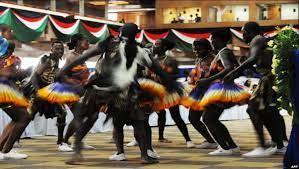Kenya is a country with diverse cultures from all of its 44 tribes or communities.
Each of these communities has unique traditional practices, including dancing.
Traditional dances were performed by specific age groups, signifying a range of rituals and customs.
Besides providing entertainment, dancing frequently played a role in rituals aimed at appeasing spirits.
It also served as a means of fostering bonding between young and older couples, as well as between parents and their children.
Dancing not only promoted physical activity but the accompanying music also conveyed valuable information to the audience.
The following are the most famous Kenyan traditional dances you ought to know.
1. Mwomboko Dance of the Agikuyu
Mwomboko is a nearly one-century-old dance initiated in the 1930s to 1940s, and inspired by the British dance, The Waltz.
Due to the nature of the dance, Mwomboko was exclusively performed by couples, encompassing individuals of various age groups, with the exception of young adults who were engaged in courtship.
Since it involved a man and woman dancing closely together, Mwomboko helped ease physical contact for those looking to wed soon.
Having withstood the test of time, Mwomboko is still performed in modern-day settings, especially at special events and in Kikuyu music videos.
Also Read: Most Popular Kikuyu Traditional Dances
2. Isukuti Dance of the Isukha and Idakho Communities
Isukuti is a traditional dance that was common in Western Kenya. The dance comprises of drumming and singing.
It was performed during celebrations such as childbirth, initiations, and weddings, among other occasions.
Though the dance is slowly fading, with only elders in the mentioned communities performing it, some modern dance groups have come together to keep its significance alive.
3. Kilumi Dance of the Kamba Community
Kambas are known for their love for music and dance.
Their most famous traditional dance was Kilumi, which was categorized into four to match the occasions on which it would be performed. These included Worship, Cleansing, Initiation, and Therapeutic Kilumi.
The dance had to be perfect for successful intervention with the spirit being called upon.
Music performed at these dances communicated their thoughts, fear, hope, and faith.
Traditionally, Kilumi was performed by older women, but men also participate in the modern society settings.
Also Read: Most Popular Kamba Traditional Dances
4. Adumu Dance of the Maasai Community
Adumu dance is what people commonly refer to as the Maasai Jump dance.
Since the old days, Adumu played a huge part in ceremonies such as weddings, festivals, and religious ritual events.
Young, agile warriors with strength and stamina performed the dance.
Besides entertainment purposes, the dance was used to determine a warrior’s bravery, endurance, and heroism, depending on the height of his jump.
The display of such qualities was (and still is) essential for their hunting and combat skills.
5. Chakacha Dance of the Swahili People
Inspired by the Persian belly dance, the Chakacha dance involves hips and waist swaying.
The Swahili people incorporated the dance with vocals and musical instruments such as drums and trumpets.
It was performed during festivals, weddings, and coastal live events.
The Chakacha dance was strictly performed by women. To facilitate fluid waist movements, they adorned light attire, often wearing a belt wrapped around their hips.
This dance spread across the Kenyan and Tanzanian coasts where the Swahili people reside.
6. Kifudu Dance of the Giriama Mijikenda Community
Kifudu is a funeral dance that promotes togetherness in times of loss.
The dance is performed by female dancers, often accompanied by male percussionists.
Once the performance commences, all those present are invited to join in and participate.
7. Nduumo of the Agikuyu
Nduumo was a female dance that united young and older women in the Gikuyu community.
It created a more bonding experience for all women generations in the community, with the passage of ‘mataaro’ (advice) from the older women to young ones.
This poetic dance music inspired more youthful women to take on the responsibilities of both a mother and wife without relying on the man to provide.
Learn more about Ndumo dance here: All You Need to Know About ‘Ndumo’ The Kikuyu dance
8. Sengenya Dance of the Digo Community
Sengenya is a ceremonial dance belonging to the Digo community in Kwale District.
The dance is performed during weddings, parties, national celebrations, and public events.
Drums played during the performance follow an orchestra pattern. Other musical instruments often accompany the drums depending on the number of instrument players.
The dance and singing can be performed during daylight or at night.
9. Ohangla Dance of the Luos
Ohangla was traditionally performed at weddings and funerals.
The dance was accompanied by drum beating and music whose lyrics were meant for a mature and intelligent audience.
The message in the song was regarded as vulgar, consisting of rude and sexually unpleasant language hidden deep in the lyrics.
As a result, alongside the use of illicit drinks and inappropriate dance moves, the dance was banned from entertaining the younger audience.
Today, Ohangla has been refined with more acceptable dancing styles and lyrics, making it suitable for a wider community audience.
Unlike the old days, it is now performed at events as a form of entertainment.
10. Taarab of the Swahili
Taarab is often associated with the Chakacha dance mainly because of the similar body movement patterns.
However, this form of dancing is associated with melodies with poetic lyrics and Arab dancing styles.
The music follows a slower rhythm compared to Chakacha, and the message tends to comprise of criticism.
Wrap Up
Though not much emphasis is put on traditional dancing today, that’s not to say we cannot keep the spirit alive.
Dancing brought communities together and helped them live in harmony.
It also created a perfect escape from everyday troubles and worries while passing down traditions to the younger generations.
Some of the dances mentioned above are performed live at the Bomas of Kenya every day of the week.

